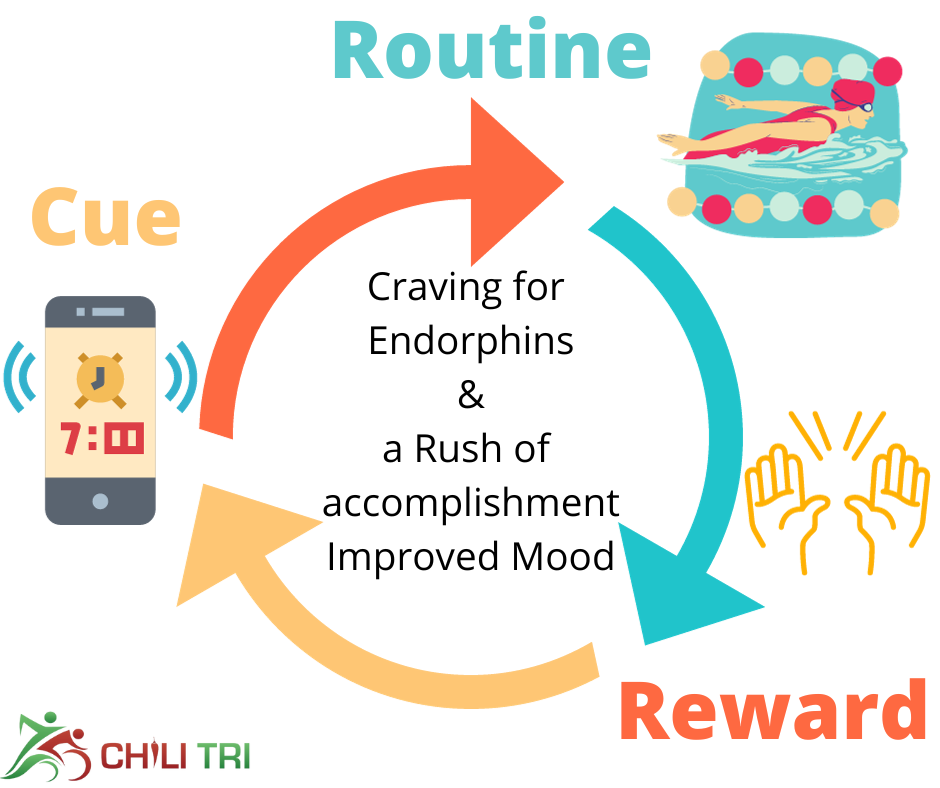Habit Stacking and Strength Snacking for Triathletes
 Karen Parnell
May 18, 2021
Karen Parnell
May 18, 2021

Habit Stacking and Strength Snacking for Triathletes
I came across this term of Habit Stacking a few months ago and it has proven to be amazingly simple and effective for me to help get my strength training done.
It’s a simple concept of adding something that you want to become a habit to a habit you already have.
One that has worked for me was to add calf raises (which I found were easy not to do daily) to something I do every day which is brushing my teeth.
So, every morning when I brush my teeth a complete my calf raises, 15 single leg calf raises left and right three times through. This ensures I get it done plus it makes sure I brush thoroughly! This calf raise protocol strengthens your calf and ankles plus helps stabilise your knee which helps prevent injury when running.
By stacking something you would like to be a habit with an existing habit you are more likely to do it and over about 6 weeks this stacked habit will become just a new habit. You could call is "strength snacking".
Other examples of habit stacking could be:
- 3 x 15 Body weight squats when making you morning coffee.
- Oatmeal’s in the microwave: Do 3 x 10 countertop push-ups
- Your favourite news show is on: Try a sun salutation.
- Planking whilst your Garmin finds satellite lock!
This methodology is great if you have been given rehab or prehab exercises or drills.
The Habit Stacking Formula is:
After/Before/During [CURRENT HABIT], I will [NEW HABIT].
E.g. During my kettle boiling for my cup of tea, I will complete 10 bodywieght squats.

Get your FREE Guide to Stregnth and Conditioning
Tapping into the Habit Loop for Athletes
The habit loop is a concept popularized by Charles Duhigg in his book "The Power of Habit." It describes a neurological pattern that governs any habit, whether it's a simple daily routine or a more complex behavior. The habit loop consists of three components:
- Cue/Trigger: This is the first stage of the habit loop, where the habit is initiated. It's the cue or trigger that signals to your brain to go into automatic mode and select a particular habit. Cues can be external (such as a specific time of day, a location, or a particular person) or internal (such as an emotional state or a preceding action).
- Routine/Behaviour: The routine is the actual behaviour or action that follows the cue. It's the habitual response that has been associated with the trigger. This is the part of the loop that people typically think of as the "habit" itself.
- Reward: The reward is the positive outcome or reinforcement associated with completing the routine. It's what tells your brain that the habit loop is worth remembering and repeating in the future. The reward reinforces the connection between the cue and the routine, strengthening the habit loop.
Over time, as this loop repeats, a habit becomes more ingrained and automatic. Understanding the habit loop is crucial for those looking to change or develop habits, as it allows you to identify and modify specific elements within the loop to create lasting behavioural change.

The Habit Loop: The Key to Habit Stacking
Get your FREE Mobility Challenge
What New Habits do you Want to Do? How will you Stack it with an Existing Habit?
The reason habit stacking works so well is that your current habits are already built into your brain. You have patterns and behaviours that have been strengthened over years. By linking your new habits to a cycle that is already built into your brain, you make it more likely that you will stick to the new behaviour.
Once you have mastered this basic structure, you can begin to create larger stacks by chaining small habits together. This allows you to take advantage of the natural momentum that comes from one behaviour leading into the next.

Get your FREE Guide to Stregnth and Conditioning
Conclusion: Habit Stacking and Exercise Snacking for Athletes
In wrapping up, habit stacking is your go-to strategy as a triathlete looking to effortlessly weave strength training into your demanding routine.
By cleverly layering strength exercises onto your existing habits, you can turn ordinary moments into opportunities for growth. Think of "habit stacking" as your personal catalyst for change, erasing the gap between your intention and action.
As you dive into the world of "strength snacking" you're not just boosting your physical capabilities; you're also cultivating a mindset that values efficiency and steadfast commitment.
In the world of triathlon, where every second matters, habit stacking is your secret weapon. It allows you to conquer the challenges of strength training, leaving you stronger, fitter, and more resilient than ever.
So, let the rhythm of habit stacking sync with your triathlon journey, and experience firsthand the transformative power it brings to your pursuit of peak performance.
Karen Parnell is a Level 3 British Triathlon and IRONMAN Certified Coach, 8020 Endurance Certified Coach, WOWSA Level 3 open water swimming coach and NASM Personal Trainer and Sports Technology Writer.
Karen is currently studying for an MSc in Sports Performance Coaching at the University of Stirling.
Need a training plan? I have plans on TrainingPeaks and FinalSurge:
I also coach a very small number of athletes one to one for all triathlon and multi-sport distances, open water swimming events and running races, email me for details and availability. Karen.parnell@chilitri.com
Get your FREE Guide to Running Speed and Technique
Get your FREE Swim Workouts for Triathletes E-book
Get your FREE Open Water Swimming Sessions E-Book
FAQ: Habit stacking for athlete motivation
What is habit stacking?
Habit stacking is a technique that involves linking a new habit with an existing habit. It leverages the power of established routines to make it easier to adopt and maintain new habits. By stacking a new habit onto an existing one, athletes can create a seamless and efficient system for motivation and productivity.
How can habit stacking improve athlete motivation?
Habit stacking can improve athlete motivation by creating a consistent routine and making desired behaviours automatic. By attaching a new habit to an existing one, athletes can leverage the existing momentum and mental associations to build motivation and make it easier to follow through with their goals.
How do I start habit stacking as an athlete?
To start habit stacking as an athlete, follow these steps:
- Identify existing habits: Take inventory of your current habits and routines. Identify ones that are well-established and occur consistently.
- Determine desired new habits: Identify specific habits or behaviours that will enhance your athletic performance or motivation.
- Find a natural pairing: Look for existing habits that naturally precede or follow your desired new habit.
- Create an implementation plan: Clearly define the specific trigger or cue that will signal the start of the new habit and map out the steps to follow after the existing habit.
Can you provide an example of habit stacking for athlete motivation?
Certainly! Here's an example: Let's say you want to establish a habit of doing core exercises to improve your overall strength and stability. If you already have a consistent habit of stretching after your workout, you can stack the new habit by committing to doing a set of core exercises immediately after your stretching routine. This way, every time you finish stretching, it serves as a trigger to automatically start your core exercises.
How long does it take for habit stacking to become effective?
The time it takes for habit stacking to become effective can vary depending on the individual and the habit being formed. On average, it can take anywhere from a few weeks to a couple of months to establish a new habit. Consistency and repetition are key factors in solidifying the habit stacking practice.
Can I stack multiple habits at once?
While it is possible to stack multiple habits at once, it is generally recommended to start with one habit at a time. Focusing on one habit allows you to give it your full attention and increases the likelihood of successful adoption. Once the first habit is firmly established, you can gradually introduce additional habits.
How can I stay motivated to maintain my habit stack?
Here are a few tips to stay motivated with your habit stack:
- Set clear goals: Define your specific goals and regularly remind yourself of the benefits and reasons behind the habits you're working on.
- Track your progress: Keep a log or use habit-tracking apps to monitor your consistency and progress. Seeing your accomplishments can boost motivation.
- Celebrate milestones: Celebrate your achievements and reward yourself when you reach significant milestones. This reinforces the positive association with your habit stack.
- Find accountability: Share your habit stack with a training partner, coach, or supportive friend who can help keep you accountable and provide encouragement along the way.
Remember, the key to habit stacking is consistency and repetition. With time and practice, habit stacking can become an effective tool for boosting athlete motivation and achieving long-term success.
References
Habit formation - PMC (nih.gov)
Habit Stacking: How to Build New Habits by Taking Advantage of Old Ones (jamesclear.com)
Habit Formation | Psychology Today
The Power of Habit: Why We Do What We Do, and How to Change by Charles Duhigg
#habitstacking #triathloncoach #triathlon #swimming #running #cycling #trainingcamps #trianingplans #chilitri #openwaterswimming #swimmingtrainingplan #cyclingtrainingplan #runningtrainingplan #swimming #cycling #running
